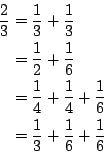poj 1980 Unit Fraction Partition 分数划分,将分数分解为n个真分数之和,分母乘积不超过a
2011-02-24 16:54
561 查看
Unit Fraction Partition
Description
A fraction whose numerator is 1 and whose denominator is a positive integer is called a unit fraction. A representation of a positive rational number p/q as the sum of finitely many unit fractions is called a partition of p/q into unit fractions. For example, 1/2 + 1/6 is a partition of 2/3 into unit fractions. The difference in the order of addition is disregarded. For example, we do not distinguish 1/6 + 1/2 from 1/2 + 1/6.
For given four positive integers p, q, a, and n, count the number of partitions of p/q into unit fractions satisfying the following two conditions.
The partition is the sum of at most n many unit fractions.
The product of the denominators of the unit fractions in the partition is less than or equal to a.
For example, if (p,q,a,n) = (2,3,120,3), you should report 4 since

enumerates all of the valid partitions.
Input
The input is a sequence of at most 200 data sets followed by a terminator.
A data set is a line containing four positive integers p, q, a, and n satisfying p,q <= 800, a <= 12000 and n <= 7. The integers are separated by a space.
The terminator is composed of just one line which contains four zeros separated by a space. It is not a part of the input data but a mark for the end of the input.
Output
The output should be composed of lines each of which contains a single integer. No other characters should appear in the output.
The output integer corresponding to a data set p, q, a, n should be the number of all partitions of p/q into at most n many unit fractions such that the product of the denominators of the unit fractions is less than or equal to a.
Sample Input
Sample Output
| Time Limit: 1000MS | Memory Limit: 30000K | |
| Total Submissions: 2797 | Accepted: 1077 |
A fraction whose numerator is 1 and whose denominator is a positive integer is called a unit fraction. A representation of a positive rational number p/q as the sum of finitely many unit fractions is called a partition of p/q into unit fractions. For example, 1/2 + 1/6 is a partition of 2/3 into unit fractions. The difference in the order of addition is disregarded. For example, we do not distinguish 1/6 + 1/2 from 1/2 + 1/6.
For given four positive integers p, q, a, and n, count the number of partitions of p/q into unit fractions satisfying the following two conditions.
The partition is the sum of at most n many unit fractions.
The product of the denominators of the unit fractions in the partition is less than or equal to a.
For example, if (p,q,a,n) = (2,3,120,3), you should report 4 since

enumerates all of the valid partitions.
Input
The input is a sequence of at most 200 data sets followed by a terminator.
A data set is a line containing four positive integers p, q, a, and n satisfying p,q <= 800, a <= 12000 and n <= 7. The integers are separated by a space.
The terminator is composed of just one line which contains four zeros separated by a space. It is not a part of the input data but a mark for the end of the input.
Output
The output should be composed of lines each of which contains a single integer. No other characters should appear in the output.
The output integer corresponding to a data set p, q, a, n should be the number of all partitions of p/q into at most n many unit fractions such that the product of the denominators of the unit fractions is less than or equal to a.
Sample Input
2 3 120 3 2 3 300 3 2 3 299 3 2 3 12 3 2 3 12000 7 54 795 12000 7 2 3 300 1 2 1 200 5 2 4 54 2 0 0 0 0
Sample Output
4 7 6 2 42 1 0 9 3
#include<iostream>
#include<cstdio>
#include<algorithm>
using namespace std;
int cnt;
int p,q,a,n;
void dfs(int t,int pl,int tp,int tq,int fac)
{
if(fac>a) return ;
if(p*tq==q*tp&&tq!=0) {cnt++;return ;}
if(pl>=n) return ;
if(p*tq<q*tp) return ;
//用t 1/t+tp/tq=(tq+t*tp)/(t*tq);
int x,y;
if(tq){
x=tq+t*tp,y=t*tq;
}
else x=1,y=t;
if(fac*t<=a) dfs(t,pl+1,x,y,fac*t);
//不用t fac*(t+1)<=a 剪枝很重要
if(t+1<=a&&fac*(t+1)<=a) dfs(t+1,pl,tp,tq,fac);
}
int main()
{
while(scanf("%d%d%d%d",&p,&q,&a,&n)==4&&q)
{
cnt=0;
dfs(1,0,0,0,1);
printf("%d/n",cnt);
}
return 0;
}
相关文章推荐
- Poj 1980 Unit Fraction Partition (分数分解 搜索)
- poj 1980 Unit Fraction Partition
- [POJ1980]Unit Fraction Partition(搜索)
- POJ_1980_Unit Fraction Partition
- poj 1980 dfs+剪枝(Unit Fraction Partition)
- [POJ 1980] Unit Fraction Partition Dfs
- POJ 1980 Unit Fraction Partition(dfs)
- poj 1980 Unit Fraction Partition 深搜剪枝
- poj-1980 Unit Fraction Partition **
- poj&nbsp;1980&nbsp;Unit&nbsp;Fraction&nbsp;Partition…
- 暴搜之1980 Unit Fraction Partition
- (Relax 水题1.2)POJ 1032 Parliament(将n分解成若干个互不相等的整数的和,并且是这些整数的乘积最大)
- POJ 1930 Dead Fraction (小数化分数)
- POJ - 1930 Dead Fraction(将小数化为分数)
- POJ 1930 Dead Fraction(循环小数化分数)
- 第一题 定义分数(Fraction)类: 1、成员变量:分子、分母 2、方法: (1)自定义初始化方法(初始分子和分母) (2)分子的赋值、取值方法 (3)分母的赋值取值方法 (4)打印分数信息
- 【POJ1032】把一个数分解为不重复的数的和使其乘积最大
- FOJ 1075假设x是一个正整数,它的值不超过65535(即1<x<=65535),将x分解为若干个素数的乘积。
- POJ 1930 Dead Fraction (无限循环小数转化为分数)
- 3. 定义一个分数类(Fraction) 实例变量:分子,分母 方法:初始化方法(2个参数),便利构造器,约分,打印,加,减,乘,除。
